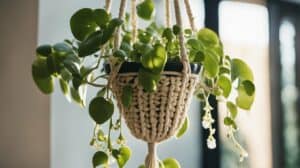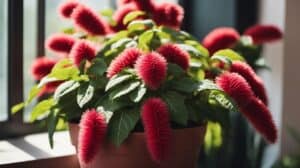The Pitcher Plant, also known as Nepenthes Alata, is a carnivorous plant that is known for its unique and captivating appearance.
These plants are native to Southeast Asia and are commonly found in countries such as Indonesia, Malaysia, and the Philippines.
The Pitcher Plant is a popular choice for plant enthusiasts due to its fascinating ability to trap and digest insects.

Caring for a Pitcher Plant can be a rewarding experience, but it requires some specific knowledge and attention.
These plants thrive in warm and humid environments, and they require a lot of water and sunlight to grow properly.
In addition, they need to be planted in a well-draining soil mixture that is rich in nutrients.
Proper care and attention will help ensure that your Pitcher Plant thrives and remains healthy for years to come.
Understanding Pitcher Plants
Species Overview
Pitcher plants, also known as Nepenthes, are carnivorous plants that belong to the Nepenthaceae family.
They are known for their unique pitcher-shaped leaves that are used to trap and digest insects.
The most commonly cultivated species is the Nepenthes alata, which is native to the Philippines.
Pitcher plants come in a variety of sizes and shapes, with some species producing pitchers that can grow up to 30 centimeters long.
The pitchers are filled with a digestive fluid that breaks down the insects that are trapped inside.
Pitcher plants also have a unique feature called the peristome, which is a ring of tissue that lines the opening of the pitcher and helps to prevent insects from escaping.
Natural Habitat
Pitcher plants are found in a variety of habitats, including rainforests, swamps, and bogs.
They are typically found in areas with poor soil quality, as they rely on insects for nutrients.
In their natural habitat, pitcher plants are often found growing in the shade of trees or in areas with high humidity.
Pitcher plants have adapted to their environment by developing unique features that allow them to thrive in nutrient-poor soils.
For example, some species have developed a symbiotic relationship with ants, which help to protect the plant from predators and provide additional nutrients to the plant.
Overall, understanding the natural habitat and unique features of pitcher plants is essential for their care and cultivation.
By providing the right growing conditions and care, these fascinating plants can thrive and provide a unique addition to any plant collection.
Essential Care Guidelines

Lighting Requirements
Pitcher plants require ample light to thrive. They should be placed in a location that receives at least 4-6 hours of direct sunlight per day.
While they can tolerate some shade, too little light can cause stunted growth and reduced pitcher production.
If growing indoors, a south-facing window is ideal.
Watering Techniques
The pitcher plant’s soil should be kept moist at all times.
Watering should be done with distilled or rainwater, as tap water can contain minerals that can harm the plant.
It is important to avoid letting the soil dry out completely, as this can cause the plant to wilt and die.
Watering should be done from the top of the pot, allowing the water to drain through the bottom.
Soil and Potting Mix
Pitcher plants require a well-draining soil that is low in nutrients. A mixture of sphagnum peat moss and perlite or sand is ideal.
Avoid using regular potting soil, as it can hold too much moisture and contain too many nutrients for the plant.
Temperature and Humidity
Pitcher plants thrive in warm and humid conditions.
They should be kept in an environment with a temperature range of 60-85°F (15-29°C) and a humidity level of 50-70%.
If growing indoors, a humidifier or tray of water near the plant can help maintain the necessary humidity levels.
It is important to avoid placing the plant near sources of cold drafts or heat, such as air conditioning vents or radiators.
By following these essential care guidelines, you can ensure that your pitcher plant (Nepenthes Alata) thrives and produces beautiful and unique pitchers.
Feeding and Nutrition

Feeding Practices
The pitcher plant is a carnivorous plant that feeds on insects and other small prey.
It traps its prey in a specialized leaf structure called the pitcher, which is filled with digestive enzymes and other fluids.
The pitcher plant’s feeding practices are quite unique, and require a bit of attention from the caregiver.
To feed a pitcher plant, the caregiver can place small insects, such as fruit flies, directly into the pitcher.
Alternatively, the caregiver can place a small amount of water in the pitcher and wait for insects to fall in on their own.
It is important to avoid overfeeding the pitcher plant, as this can cause the pitcher to rot and ultimately harm the plant.
Nutrient Absorption
The pitcher plant obtains its nutrients from the digestion of the insects and other small prey that it captures.
The digestive enzymes in the pitcher break down the prey into a nutrient-rich soup that the plant can absorb.
The pitcher plant is adapted to grow in nutrient-poor environments, and relies on its carnivorous feeding habits to obtain the necessary nutrients for growth and survival.
It is important to note that the pitcher plant should not be fertilized with traditional plant fertilizers, as this can harm the plant’s delicate digestive system.
Instead, the pitcher plant should be allowed to obtain its nutrients naturally through its feeding practices.
With proper care and attention, the pitcher plant can thrive and provide a unique addition to any plant collection.
Common Issues and Solutions

Pest Management
Pitcher plants are relatively pest-free, but they can sometimes be affected by aphids, spider mites, and mealybugs.
These pests can damage the leaves and pitchers of the plant, and if left untreated, they can even kill the plant.
To manage pest infestations, it is recommended to regularly inspect the plant for signs of pests.
If any pests are found, they can be removed manually using a cotton swab dipped in rubbing alcohol.
In severe cases, an insecticidal soap or neem oil can be used to control the infestation.
Disease Prevention
Pitcher plants can also be susceptible to fungal and bacterial diseases, which can cause the leaves and pitchers to rot.
To prevent these diseases, it is important to keep the plant’s environment clean and well-ventilated.
Avoid overwatering the plant, as this can create a damp environment that is conducive to fungal growth.
It is also important to use clean tools when handling the plant, as contaminated tools can spread diseases from one plant to another.
If the plant does become infected with a disease, it is recommended to remove the affected leaves or pitchers and dispose of them properly.
The remaining plant can then be treated with a fungicide or bactericide to prevent further spread of the disease.
By following these pest management and disease prevention tips, you can ensure that your pitcher plant stays healthy and vibrant.
Frequently Asked Questions

What type of soil is best for growing Nepenthes alata?
Nepenthes alata prefers a well-draining, nutrient-poor soil mix. A recommended mix would be a 1:1 ratio of sphagnum moss and perlite.
Avoid using soil that is high in nutrients, as this can harm the plant.
How often should I water my Nepenthes alata pitcher plant?
Nepenthes alata prefers to be kept consistently moist, but not waterlogged. Water the plant thoroughly when the top layer of soil feels dry to the touch.
This may vary depending on the environment, but a general rule of thumb is to water every 7-10 days.
What is the ideal temperature range for Nepenthes alata to thrive?
Nepenthes alata prefers temperatures between 70-80°F during the day and 60-70°F at night.
However, it can tolerate temperatures outside of this range as long as it is not exposed to extreme heat or cold for prolonged periods of time.
Can Nepenthes alata be grown indoors, and if so, how?
Yes, Nepenthes alata can be grown indoors as long as it receives adequate light and humidity.
Place the plant near a bright window that receives indirect sunlight for 6-8 hours a day and maintain a humidity level of 50-70%.
Consider using a humidifier or placing the plant on a tray filled with pebbles and water to increase humidity.
What are the propagation techniques for Nepenthes alata?
Nepenthes alata can be propagated through stem cuttings or by seed.
Stem cuttings should be taken from healthy mature plants and placed in a well-draining soil mix.
Seeds should be sown in a soil mix that is kept moist and warm.
Does Nepenthes alata require a dormancy period, and how is it managed?
Yes, Nepenthes alata requires a dormancy period during the winter months.
During this time, the plant’s growth slows down and it may produce smaller leaves.
To manage dormancy, reduce watering and fertilization and maintain a cooler temperature range of 50-60°F.
Resume normal care in the spring when new growth appears.














